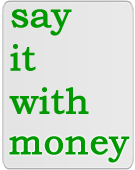The "Say It With Money" project examines our relationship with money in general, and, more specifically, the psychology of giving. The central objects of study here are 1) the semantics of giving money and 2) the semantics of how others perceive the act of someone else giving money.
1) We as consumers are used to receiving a product in return for our money: what forms can this product take? Is simple satisfaction of having given money enough of a product? Has the act of paying, through the process of consumeristic psychological imprinting, become pleasurable in and of itself?
2) If someone bothered enough to give money, immediately, there is a perceived importance attached to the subject matter (more so than, e.g., in the case of someone simply giving their time). The value system dynamics thus evolving is closely related to the questions of the interplay between the pecuniary ...
Full Description
The "Say It With Money" project examines our relationship with money in general, and, more specifically, the psychology of giving. The central objects of study here are 1) the semantics of giving money and 2) the semantics of how others perceive the act of someone else giving money.
1) We as consumers are used to receiving a product in return for our money: what forms can this product take? Is simple satisfaction of having given money enough of a product? Has the act of paying, through the process of consumeristic psychological imprinting, become pleasurable in and of itself?
2) If someone bothered enough to give money, immediately, there is a perceived importance attached to the subject matter (more so than, e.g., in the case of someone simply giving their time). The value system dynamics thus evolving is closely related to the questions of the interplay between the pecuniary and the memetic subsystems in a capitalist framework: the state of the art of the memetic weaponry of marketing has reached such heights that it is no longer a question of whether money can be traded directly for the spread and importance of targeted ideas.
The work currently consists of two parts: "Say It With Money Email" and "Say It With Money Issues".
"Say It With Money Email" allows the participant to pay for something that is usually free: to send an email message. The meaning of the message at the receiving end seems to undergo a magical transformation when the receiving party understands that the delivery of this message has been voluntarily paid for by the sender.
"Say It With Money Issues" allows the participant to state their opinion on a particular controversial issue by giving $1. A database keeps track of how many people gave money to each of the issues.
Work metadata
- Year Created: 2006
- Submitted to ArtBase: Tuesday Feb 14th, 2006
- Original Url: http://www.hrum.org/SayItWithMoney/about.html
- Permalink: http://www.hrum.org/SayItWithMoney/about.html
-
Work Credits:
- None, creator
Take full advantage of the ArtBase by Becoming a Member
Artist Statement
The "Say It With Money" project examines our relationship with money in general, and, more specifically, the psychology of giving. The central objects of study here are 1) the semantics of giving money and 2) the semantics of how others perceive the act of someone else giving money.
1) We as consumers are used to receiving a product in return for our money: what forms can this product take? Is simple satisfaction of having given money enough of a product? Has the act of paying, through the process of consumeristic psychological imprinting, become pleasurable in and of itself?
2) If someone bothered enough to give money, immediately, there is a perceived importance attached to the subject matter (more so than, e.g., in the case of someone simply giving their time). The value system dynamics thus evolving is closely related to the questions of the interplay between the pecuniary and the memetic subsystems in a capitalist framework: the state of the art of the memetic weaponry of marketing has reached such heights that it is no longer a question of whether money can be traded directly for the spread and importance of targeted ideas.
The work currently consists of two parts: "Say It With Money Email" and "Say It With Money Issues".
"Say It With Money Email" allows the participant to pay for something that is usually free: to send an email message. The meaning of the message at the receiving end seems to undergo a magical transformation when the receiving party understands that the delivery of this message has been voluntarily paid for by the sender.
"Say It With Money Issues" allows the participant to state their opinion on a particular controversial issue by giving $1. A database keeps track of how many people gave money to each of the issues.





